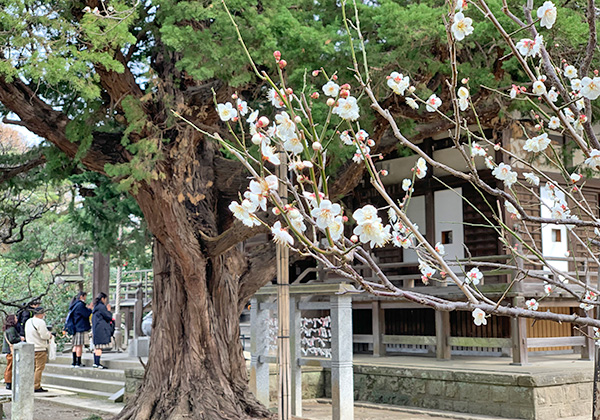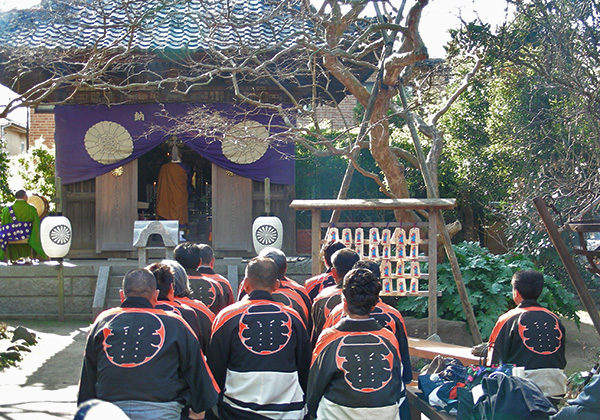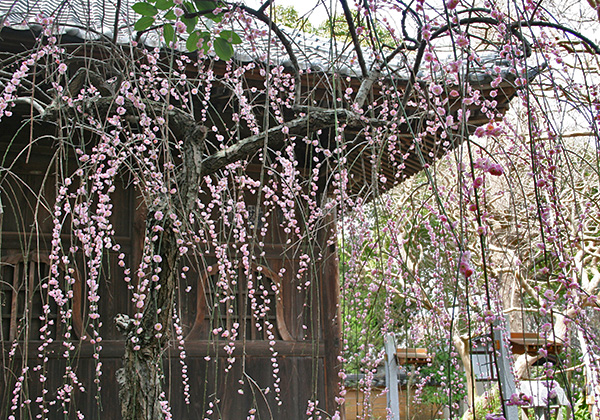Hokaiji
| Official Name | Kinryuzan Shakuman-in Endon Hokaiji {Pronounced kin-ryu-zan shak-man-in en-don hoh-kye-gee} |
|---|---|
| Religious sect | Tendai sect, Buddhism |
| Founded | in 1335 by Emperor Godaigo {go-dye-go} and Takauji Ashikaga {tah-kah-woo-gee ah-she-kah-gah} |
| Founding priest | Echin Enkan {eh-chin yen-kan} |
| Main object of worship | Statue of Jizo Bosatsu or Ksitigarbha-Bodhisattva in Sanskrit |
| Address | 5-22, Komachi 3-chome, Kamakura, Kanagawa 248-0006 (show route from current location ) |
| Location | 800 meters northeast of Kamakura Station |
| Time needed to get there | 15 minutes |
| Admission | JPY300 |
| Open | April-September: 9:30-16:30 October - March: 9:30-16:00 |
| Phone number | 0467-22-5512 |
| Restrooms | Not available |
Historical Overview
The Kamakura Period ended its one-and-a-half century rule in 1333 when the resurgent loyalist troops led by Yoshisada Nitta {yo-she-sah-dah nit-tah} (1302-1338) attacked and destroyed Kamakura after a fierce battle. Knowing the defeat was imminent, 870-odd samurai of the Hojo clan headed by Takatoki Hojo {tah-Kah-toh-key hoh-joe} (1303-1333), the 14th Hojo Regent, committed mass suicide at the temple called Toshoji {toh-sho-gee}, which existed 200 meters southeast of today's Hokaiji, near Redemptoristine Convent. At the same time, they burned out the temple so that no samurai were identifiable to the enemy. Toshoji was the family temple for the Hojos and was said to have been like a fortress. As proved by the excavations in 1975 and 1976, code of samurai always calls for suicide rather than surrender. It was honored even during World War II.
Today, the neighborhood is packed with private houses and there is nothing to remind us of the tragic days of the past. The only spot reminiscent of the disaster is the Yagura {yah-goo-rah} cave dug at the foot of a hill near the Toshoji ruins. It is called Takatoki Harakiri (seppuku) Yagura, where remains of those who committed harakiri were buried, but only a gorinto (five-tier tomb) can be seen. If you visit here alone and there is no one else, perhaps you may feel a weird air. (Meanwhile, The American Heritage Dictionary, Third Edition, reads in its "seppuku" that "seppu, to cut + ku, abdomen". This is wrong. Seppuku is a combination of setsu (cut) and fuku (abdomen) becoming seppuku for an easy pronunciation.)
When Takatoki Hojo took the post of the 14th Hojo Regent in 1316, he was only 13 years old, too young to be a ruler. In addition, the power of the Shogun was no longer as strong as it had been before. Initiated by Emperor Godaigo (1288-1339), Nitta troops with over 100,000 warriors attacked Kamakura in 1333 to topple the Shogunate and Hojo regime. Hojo clan's samurai fought back bravely, but the goddess of victory did not side with them. Takatoki had to take his own life at age 31. To mourn for the dead, Takatoki in particular, Emperor Godaigo instructed Takauji Ashikaga (1305-1358), the First Shogun of the Muromachi Period (1336-1573), to erect the Temple inviting Priest Enkan (1281-1356), a famous Tendai sect priest in Kyoto, as the founder. However, Priest Enkan himself was one of the priests who had invocated for the fall of the Hojo regime at the request of Emperor Godaigo.
The Temple stands right on the site where chieftains of the Hojos resided generation after generation. As if to show the past glory, the Hojo's emblem, triangles made up with black and gold, appears on the Temple gate and roof's tiles. The second chief priest Yuiken Shokei {you-e-ken shoh-kay} (1289-?) was a disciple of Priest Enkan and contributed to enlarging the Temple into a full-scale monastery.
Hokaiji is one of the two Tendai sect temples in Kamakura. The other is Sugimoto-dera.
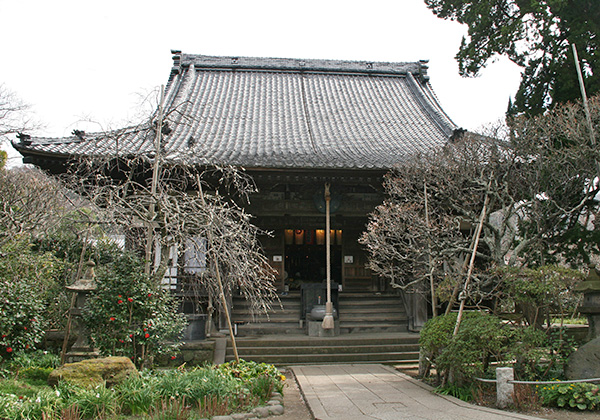
Hondo {hon-doh} or Main Hall
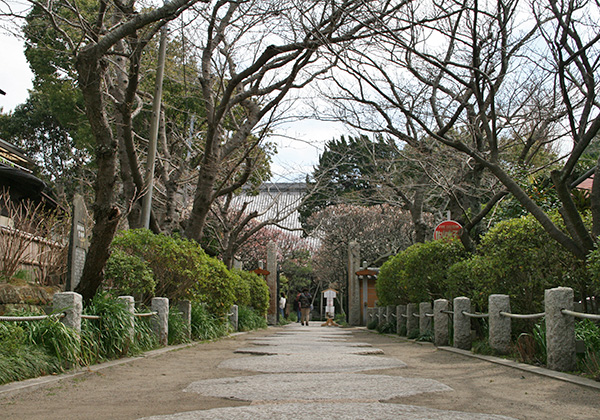
The main object of worship is a sedentary statue of Jizo Bosatsu, a guardian deity of children. The 91-centimeter tall wooden statue, an Important Cultural Asset, was fashioned in 1365 by Ken-en Sanjo {ken-yen san-joe} (birth and death years unknown), a famous Kyoto sculptor in the 14th century, with a staff in its right hand and a string of beads in its left, a typical Jizo Bosatsu statue. Since Jizo is also believed to save the souls of those who are undergoing the hellish agony in the netherworld, the statue is most suitable here in that it can console the souls of Takatoki and many other war-dead. The statue is the first of the Twenty-Four Jizo Pilgrimage in Kamakura.
As Ken-en was a sculptor in Kyoto, the statue has some hints of Kyoto style, not Chinese ones observed in many other statues in Kamakura. Why Kyoto sculptors? Because, the Temple was constructed under the instruction of Emperor Godaigo in Kyoto.
Flanking the Jizo Bosatsu statue are life-size statues of Bonten or Brahma-Deva in Skt., and Taishakuten {tie-shak-ten} or Sakra Devanam Indra in Skt., both are excellent works made during the 14th century probably by Ken-en himself or one of Sanjo-school sculptors and are designated as ICAs by the Prefectural Government. In Kamakura, their works can be seen only in the Temple.
In front of the Jizo Bosatsu statue are Ten Devas. On the right-hand recess are the statue of the Lord of Hades or Yama, and that of Takatoki Hojo. On the left of the Jizo Bosatsu flank the statues of Fudo Myo-o (the Immovable) or Acala-vidyaraja and that of Jundei Kan'non or Cundi in Skt., which is listed on the second of the Kamakura Thirty-Three Kan'non Pilgrimage. Visitors are allowed to go inside the hall and worship those statues real close.
Another ICA in this hall is a 97.1-centimeter tall sedentary statue of Priest Shokei, the second chief priest. It was made when he was 84 years old by a sculptor named "Chokei". Despite its excellent works, nothing is known about him except that he was an active sculptor in the latter half of the 14th century. Tendai sect Buddhists seem to have had customs to make statues of the prominent priest like those of Zen priests. Priest Shokei was honored with a posthumous name of Fusen {foo-sen} the National Teacher and left a number of sutra transcripts, which are precious documents even today for those who study the Tendai doctrines in Kanto (the greater Tokyo area). In fact, the Temple once used to be among the largest Tendai school in eastern Japan.
At 1:30 p.m. on 24th every month, a ceremony for the Jizo Bosatsu is held with the holy fire. The hall is relatively new, rebuilt in 1932.

